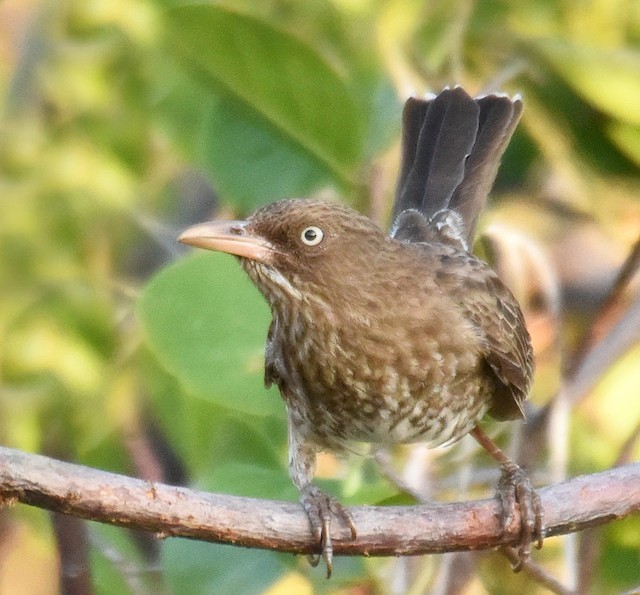Birdfinding.info ⇒ Locally abundant and conspicuous on many small islands, especially on Mona, Culebra, Vieques, the Virgin Islands, and the Leeward Islands south to Montserrat. On larger islands where it occurs mainly in dense forest, such as Martinique, it tends to be uncommon and shy. In the Bahamas, it is uncommon to rare except on San Salvador where it is very common. On Bonaire, it appears to be limited to the north end of the island in and around Washington-Slagbaai National Park. In the D.R., it is fairly common in the vicinity of Punta Cana, but otherwise not well established. On Puerto Rico, it is very common throughout the island in most habitats—the lone exception to its general inability to thrive on large islands with diverse avifaunas.
Pearly-eyed Thrasher
Margarops fuscatus
Endemic to islands of the eastern Caribbean. A habitat generalist that occurs in wet and dry forests, open woodlands, scrub, gardens, and urban areas.
Notably prone to range expansions and contractions. Current range consists mainly of small islands along the eastern rim of the West Indies from Abaco south to Great Inagua and Turks & Caicos, eastern Hispaniola, Beata, Mona, Puerto Rico, and east through the Virgin and Leeward Islands, then south through the Lesser Antilles to St. Lucia; and separately on Bonaire. Formerly occurred on Jamaica, St. Vincent, Barbados, and the tiny Venezuelan island La Horquilla (northernmost of the Los Hermanos archipelago).
In recent decades it has spread northward in the Bahamas, colonizing Cat Island, Eleuthera, New Providence, and Abaco, although it apparently has not established stable populations on most of those islands. It has also begun to colonize eastern Hispaniola around Punta Cana, and has been found occasionally westward along the coasts as far as Cap-Haitien and Santo Domingo.
Identification
A large, robust, mostly brown thrasher with a bright white staring eye, a heavy, horn-colored bill, and large white undertail patches.
The upperparts are mottled in shades of brown. The underparts from the throat to the lower breast are densely covered with brown chevrons—sometimes sharply defined and sometimes blurred.
Often behaves more like a jay than like a typical thrasher: noisily barging onto a scene in squabbling groups, taking scraps of food from picnic tables, etc.
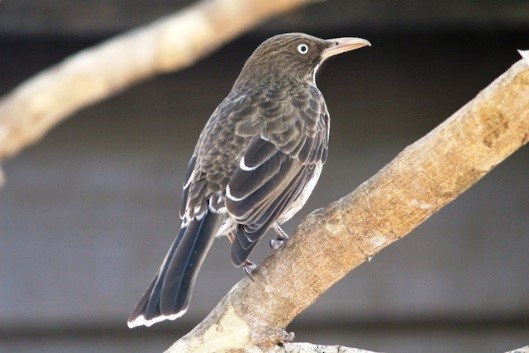
Pearly-eyed Thrasher, showing mottled upperparts and white tail-tip. (La Parguera, Puerto Rico; December 28, 2011.) © Brad Bergstrom
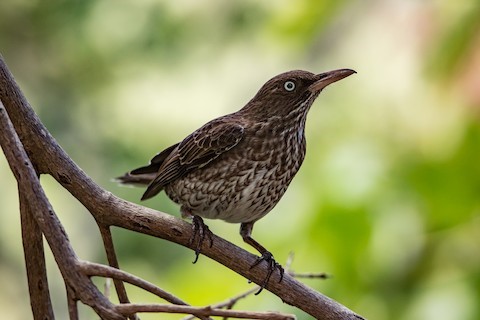
Pearly-eyed Thrasher, showing chevron pattern on underparts. (Emilio Wilson Park, St. Martin; January 6, 2018.) © Binkie Van Es
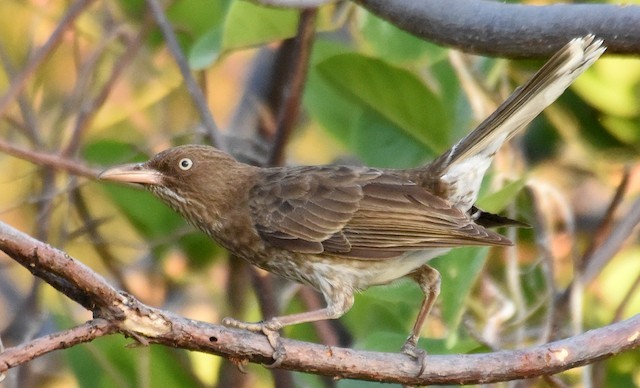
Pearly-eyed Thrasher. (Majors Bay Pond, St. Kitts; March 6, 2018.) © Steven Mlodinow

Pearly-eyed Thrasher. (Emerald Pool, Dominica; October 19, 2018.) © Peter Kaestner
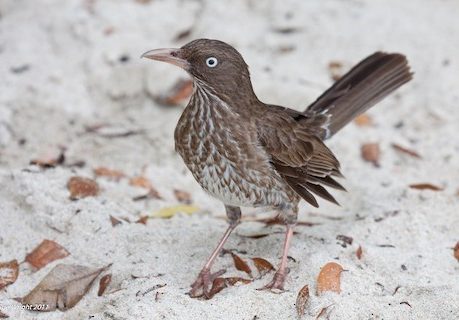
Pearly-eyed Thrasher, likely soliciting food from the photographer. (Magen’s Bay Trail, St. Thomas, U.S.V.I.; May 1, 2011.) © Sue Wright
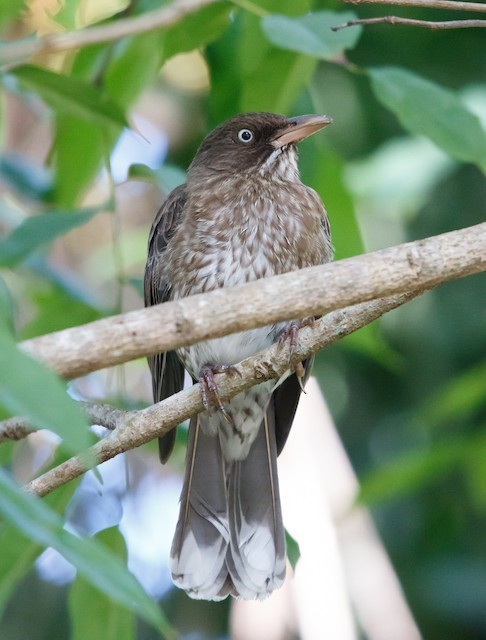
Pearly-eyed Thrasher, ventral view showing white undertail patches. (Río Piedras Botanical Garden, San Juan, Puerto Rico; February 13, 2016.) © Simon Best
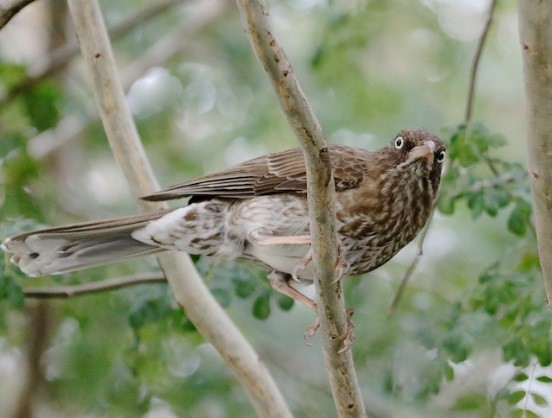
Pearly-eyed Thrasher, ventral view showing white undertail patches. (Guayanilla, Puerto Rico; March 4, 2017.) © Gil Ewing

Pearly-eyed Thrasher, an unusually reddish individual. (El Yunque National Forest, Puerto Rico; August 1, 2016.) © Rob Van Epps

Pearly-eyed Thrasher, showing mottled upperparts and white tail-tip. (Guánica State Forest, Puerto Rico; December 5, 2016.) © Steve Tucker
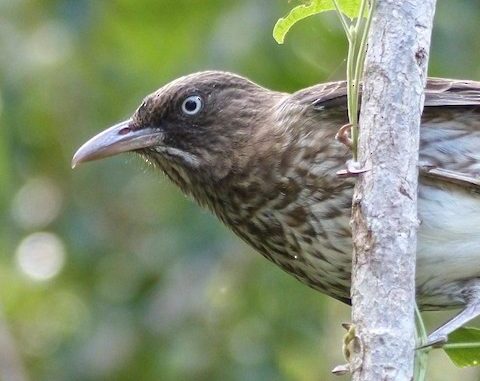
Pearly-eyed Thrasher, showing its massive horn-colored bill. (Cruz Bay, Virgin Islands National Park, St. John, U.S.V.I.; December 21, 2018.) © Narca Moore-Craig

Pearly-eyed Thrasher, scolding. (Maricao State Forest, Puerto Rico; April 19, 2014.) © Jay McGowan
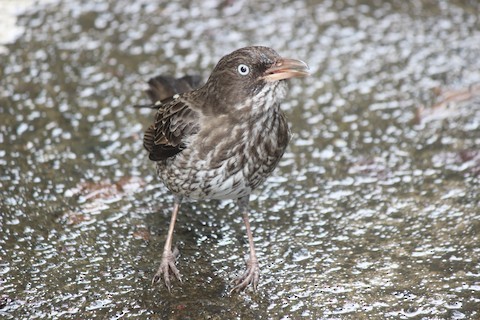
Pearly-eyed Thrasher, apparently soliciting food from the photographer. (Cascade aux Ecrevisses, Guadeloupe; November 18, 2014.) © Charles Gates
Cf. Scaly-breasted Thrasher. In most of the Lesser Antilles, Pearly-eyed can be confused with the smaller Scaly-breasted Thrasher, which has similar plumage overall, but a much smaller, dark bill, and pale yellow (not white) eyes. As its name suggests, Scaly-breasted has a scaly or scalloped pattern of curved markings on its underparts, whereas Pearly-eyed shows more angular chevrons or blurry streaks—but this distinction is not always obvious. Scaly-breasted also has evenly brown upperparts, whereas Pearly-eyed’s upperparts are mottled with a mix of darker and lighter tones.
Notes
Polytypic species consisting of four recognized subspecies.
An Ecological Explanation of the Pearly-eyed Thrasher’s Peculiar Distribution. Wayne Arendt’s 2006 paper “Adaptations of an Avian Supertramp” presents a persuasive analysis of why the Pearly-eyed Thrasher, which seems to be a supremely adaptable generalist, appears largely unable to prosper on islands with diverse avifaunas (with the exception of Puerto Rico). In essence, it appears that its generalist strategy succeeds only on islands that have several significant unoccupied niches that are productive enough to enable it to shift among different food sources when conditions change.
References
Arendt, W.J. 2017. Pearly-eyed Thrasher (Margarops fuscatus), version 1.0. In Neotropical Birds Online (T.S. Schulenberg, ed.). Cornell Lab of Ornithology, Ithaca, New York. https://doi.org/10.2173/nb.peethr1.01.
Arendt, W.J. 2006. Adaptations of an Avian Supertramp: Distribution, Ecology, and Life History of the Pearly-eyed Thrasher (Margarops fuscatus). U.S. Department of Agriculture, Forest Service, International Institute of Tropical Forestry. San Juan, Puerto Rico. https://www.fs.fed.us/global/iitf/pubs/iitf-gtr27a.pdf; http://www.fs.fed.us/global/iitf/pubs/iitf-gtr27b.pdf.
Cody, M. 2019. Pearly-eyed Thrasher (Margarops fuscatus). In Handbook of the Birds of the World Alive (J. del Hoyo, A. Elliott, J. Sargatal, D.A. Christie, and E. de Juana, eds.). Lynx Edicions, Barcelona. https://www.hbw.com/node/58184. (August 23, 2019.)
eBird. 2019. eBird: An online database of bird distribution and abundance. Cornell Lab of Ornithology, Ithaca, N.Y. http://www.ebird.org. (Accessed August 24, 2019.)
Raffaele, H. 1989. A Guide to the Birds of Puerto Rico and the Virgin Islands. Princeton University Press, Princeton, N.J.
Raffaele, H., J. Wiley, O. Garrido, A. Keith, and J. Raffaele. 1998. A Guide to the Birds of the West Indies. Princeton University Press, Princeton, N.J.
